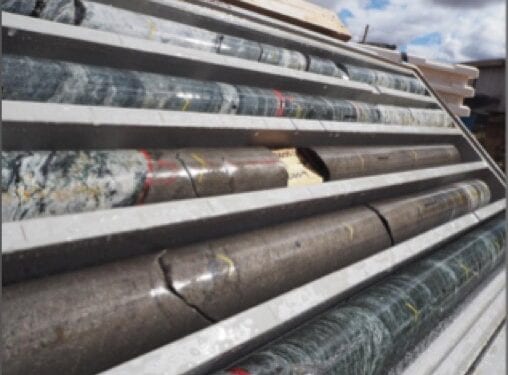New DHEM Conductors Identified
Auroch Minerals Limited (ASX:AOU) has received promising assay results of massive nickel sulphide zones intersected earlier this month in diamond drill-hole SNDD013at the Saints Nickel Project in Western Australia.
The two main zones of nickeliferous massive sulphides returned down-hole intersections of
- 1.25m @ 3.71% Ni and 0.18% Cu from 241.61mand
- 0.39m @ 3.77% Ni and 0.26% Cu from 244.08m within a broader mineralised zone of 3.68m @ 1.85% Ni and 0.26% Cu from 240.79m which included some disseminated and blebby sulphide mineralisation.
The high-grade nickel sulphide mineralisation was intersected in a hanging-wall position approximately 14 metres (down-hole) above the basal contact of the Saint Andrewschannel, coincident with a strong DHEM conductor modelled from historic data.
DHEM surveys completed on the four new diamond drill- holes using more modern higher-powered techniques resulted in several new DHEM conductors.
In SNDD013a very strong off-hole conductor (30,000 – 35,000S) was identified approximately 40m to the north of the hole, in addition to a strong in-hole conductor that was coincident with the massive sulphide intersection.
In SNDD014, a second strong (14,000 – 19,000S) off-hole conductor was modelled only 10m from the drill-hole.
Both of these strong off-hole conductors are located near the basal contact of the Saint Andrews channel and represent walk-up drill targets for the next phase of diamond drilling at Saints.
The geochemical signature and elemental ratios of the basal ultramafic unit intersected by SNDD013below the massive sulphide intervals confirmed this lowermost unit was a hot and highly fertile lava flow, with disseminated nickel sulphides throughout resulting in 4.84m @ 0.43% Ni from 253m.
Managing Director, Aidan Platel, said these results confirm the fertility of the Saint Andrews channel and the potential that it may host significant massive nickel sulphide mineralisation at the base of the channel at depth.
“We are extremely pleased with the initial results from our recent diamond drill programme at Saints,” Mr Platel said.
“The high-grade nickel results from the massive sulphide zones intersected in hole SNDD013 confirm that we are in a very nickel-rich system and that our geological and DHEM modelling is providing us with the right platform to vector in on further mineralisation in order to build upon our existing resources at Saints.
The nickel-rich results from the basal ultramafic flow, coupled with other elemental results such as Mg, have really confirmed to our technical team that the Saint Andrews channel is a very fertile channel capable of hosting significant massive nickel sulphide mineralisation at its base.
The very strong DHEM conductors sitting just off holes SNDD013 and SNDD014 were exactly what we were hoping for, and the reason for this recent drill programme.
“Where before there was a distinct lack of data to work with, we now have two very compelling drill targets for the next phase of diamond drilling as we continue to explore for that feeder channel mineralisation within the Saints system.”












